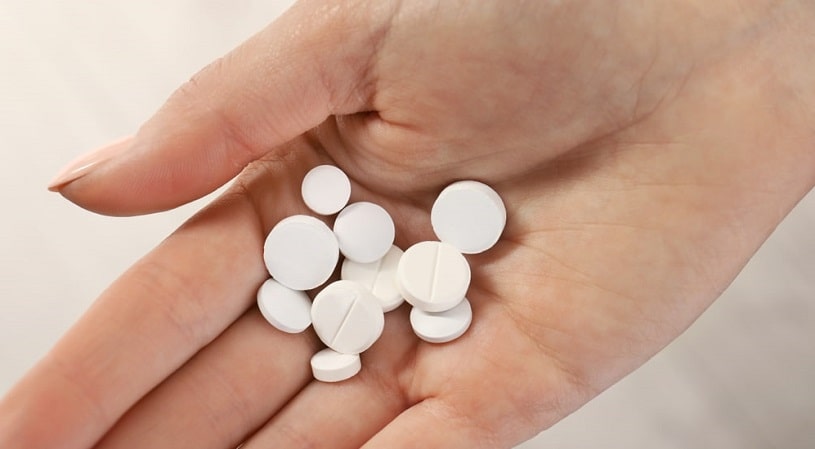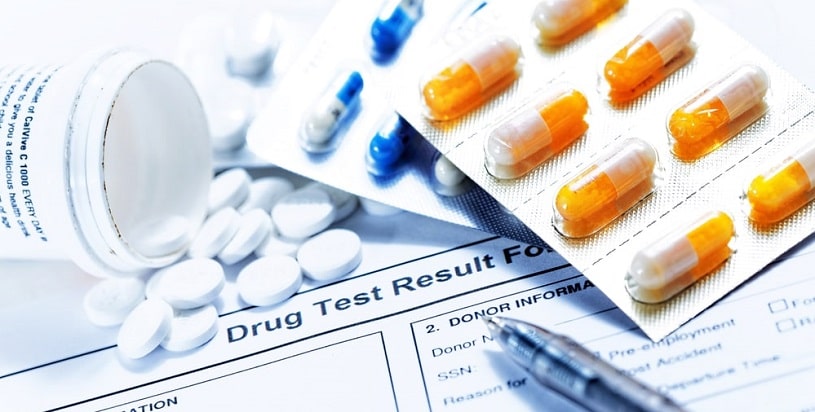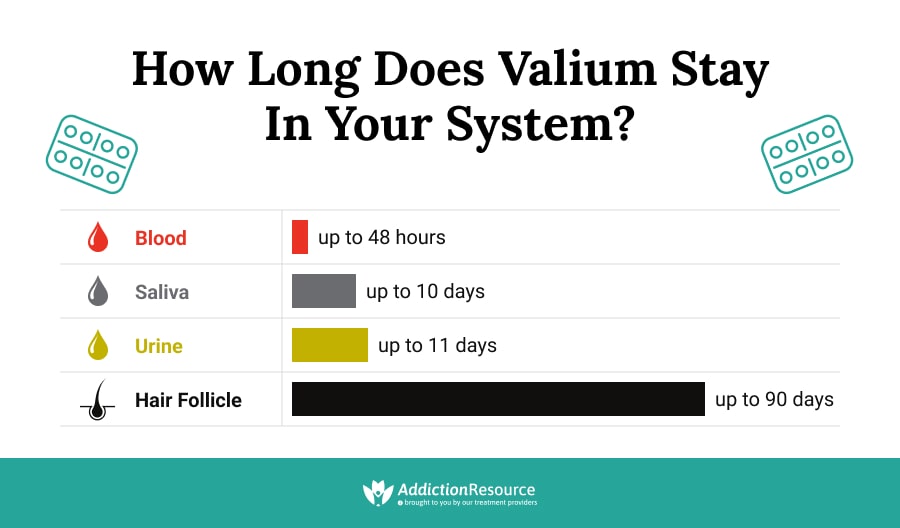Valium is the brand name of the medication diazepam. It belongs to the class of sedatives known as benzodiazepines used in the treatment of anxiety, seizures, muscle spasms, withdrawal symptoms, and so on. When the medication is administered, it carries out its actions within a specific time. Valium is metabolized by the liver, and both the active form and its various metabolites are distributed throughout the body. How long these metabolites can be detected within different tissues is directly related to the Valium half-life, which depends on several factors, which are discussed below.
Table Of Contents:
What Does Valium Do?
Valium uses include a number of health conditions, namely anxiety, insomnia, alcohol withdrawal and others. Diazepam mechanism of action works through its effects on Type A GABA receptors through positive allosteric modulation. This increases GABA (gamma-aminobutyric acid) binding, a powerful inhibitory neurotransmitter present in the Central Nervous System (CNS). Increased GABA binding to its receptors takes either 1-5 minutes or up to 40 minutes depending on whether taken intravenously or orally, respectively, and results in decreased activity at key CNS sites, including the limbic and cortical systems. When this happens, the brain experiences an overall slowdown demonstrated in the calm that results from taking it.

The effects of benzodiazepines are similar to the depressant effects of alcohol which also work through the GABA receptors. That is why combining benzodiazepine with alcohol can lead to severe and potentially life-threatening consequences.
How Long Does It Take to Work?
Benzodiazepine pharmacokinetics depends on the mode of administration. The administration is done in one of four ways: orally, intravenously, intramuscularly, and via a suppository.
- Oral: When taking Valium pills, bioavailability is 100% and will take up to 40 minutes to take effect. Peak pharmacological effects set in 30-90 minutes after administration.
- Intravenous (IV): Taken in diluted form due to its damaging impact on veins, bioavailability is 100%, and once taken, Valium effects set in within 1-5 minutes.
- Intramuscular (IM): With 100% bioavailability, effects set in within 15-30 minutes of administration. Peak plasma levels are achieved 15 minutes to 1 hour after administration for both IM and IV routes.
- Suppository: Bioavailability is lower at 90%, with peak effects being experienced after 10-45 minutes.
Diazepam Metabolism
Metabolism is a biological process that converts a substance into other chemicals. The metabolism products are called metabolites, while the portion of the medication that survives metabolism is called a parent or unchanged drug.
Diazepam metabolism occurs primarily within the liver by two important cytochrome P450 (CYP) enzymes, CYP2C19 and CYP3A4, into desmethyldiazepam, which is the major active metabolite. These other active metabolites also act similarly to the diazepam mechanism of action. Some other minor active metabolites include temazepam and oxazepam, but these are usually undetectable. Metabolism within the liver is one of significant factors which affect diazepam half-life and the diazepam mechanism of action by creating longer-lasting active metabolites.
Valium Half-life: How Long Does Diazepam Last?
Valium is classified as a fast-acting, long-lasting benzodiazepine. The onset of action varies depending on the route of administration. Upon intravenous administration, the medication’s effects can be felt within 1-3 minutes, while drug oral administration may take up to 15-60 minutes. The medication effects are long-lasting and peak within 1-2 hours of administration of the substance. These effects may last as long as 12 hours, but this can be extended upon repeated dosing of the sedative.

The Valium half-life is the length of time it takes for the initial substance amount measured within a particular tissue to reduce to half its original value. However, longer half-lives do not always mean one will experience the drug effects for a long duration, but it may help predict the duration of its action. It does not take into account the amount of the medication present in the body; rather only the drug in the blood is considered. For a medication to show its effects, it should be present in the site where it acts, not always the blood. Users may get positive urine or blood results even days or weeks after their last dose.
Factors Influencing How Long Valium Stays In The System
The half-life of Valium is dependent on several factors, some of which are related to the patient’s health status and others which are independent of the patient’s health, such as the dose of the medication.
The Factors That Influence the Half-Life of Valium Are:
- Age. If the patient is above 65, they may get a higher blood sample value. This is because clearance of diazepam and its active metabolites are reduced in elderly individuals.
- Amount of body fat. A person with obesity is more likely to retain it for longer. This is because diazepam is highly soluble in fat, leading to the drug being stored within fat cells and being slowly released, leading to it being detectable for longer than average.
- Liver health. Liver disorders like cirrhosis, for instance, due to chronic alcohol addiction or hepatitis, slow down its elimination from the body. It leads to increased serum concentrations of the drug and also increased detection time within the body. Therefore the treatment dose is usually halved in such individuals.
- Kidney health. It usually takes significant renal impairment before diazepam, and its metabolites accumulate within the body. Therefore mild renal disease does not affect treatment with benzodiazepines or the length of time they remain detectable within the blood.
- Personal metabolic rate. Individuals with higher metabolic rates may metabolize the drug more quickly, leading to reduced Valium half-life and reduced treatment efficacy.
- Dosage & Frequency. Chronic benzodiazepine addiction or long-term treatment with benzodiazepines can lead to the drug being detectable for much longer within body tissues.
- Other substances. Concurrent use of Diazepam with other drugs influences the clearance of the medication from the body in different ways. Some drugs increase the clearance of diazepam by increasing the activity of liver enzymes responsible for metabolizing the medication. They include rifampin, phenytoin, carbamazepine, and phenobarbital. Others reduce the clearance of the benzodiazepines from the body such as cobicistat, boceprevir, grazoprevir, letermovir, posaconazole, and telaprevir.
Diazepam Half-Life and Detection Times
The Valium half-life is approximately 48 hours. However, the half-life of its active metabolites can be as long as 100 hours. These values can be altered by several factors which have already been discussed previously.

Usually, the diazepam half-life is measured using blood samples, but diazepam can be detected in several other body samples such as urine, saliva, and hair. Each of these body tissues has its detection time. When users go for a test to detect the medication, they measure both the parent drug and its metabolites.
Urine Test
Urine tests are popular medical tests because they are simple, easily accessible, non-invasive, and quite effective for detecting certain substances. Generally, the substance is detectable for up to 11 days in the urine. However, urine samples of chronic abusers may test positive for as long as 6 weeks.
Blood Test
Blood testing is a more invasive method of testing for the presence of benzodiazepines within the body. Generally, the medication is only detectable in the blood for 48 hours after drug administration. This means the drug may help detect recent usage of the substance.
Saliva Test
Benzodiazepines can also be detected in the saliva of individuals who have recently ingested them. Studies have shown that the sedative and its active metabolites can remain detectable in the saliva for as long as 10 days after administering the last dose.
Hair Analysis
If an individual has been using/abusing it for the last three months, the hair analysis may show a positive test result. It may be present in the hair stands for several weeks to 3 months after they stop taking it. However, tests that use urine and blood samples are more common than hair analysis, as they show more recent evidence of addiction or use.

False-Positive Results
A false-positive result is a situation where a test wrongly indicates the presence of a substance within a given sample, in this case, the presence of benzodiazepines. Several drugs have been associated with false-positive results for Valium, such as the selective serotonin reuptake inhibitor sertraline, the non-steroidal anti-inflammatory drug (NSAID) oxaprozin, and the antiretroviral drug efavirenz.
If you are on any of these drugs, it is essential to inform your medical care provider before taking a benzodiazepine test.
Dealing With a Benzodiazepine Detox
From the above, it’s quite clear that benzodiazepines can remain within the body for an extended period. The diazepam half-life and that of its active metabolites within the blood may be as long as 100 hours, which explains its long detection time in both urine and hair samples. These values may be even higher in chronic abusers of the sedative. Therefore a Valium detox may take anywhere between a few days to several weeks in chronic abusers of the drug. That’s why it is best to seek professional help from a drug rehabilitation center that can provide you with the medical expertise and support you need to rid your body of the drug safely, deal with benzodiazepine withdrawal symptoms which is similar to alcohol withdrawal, and finally overcome your benzodiazepine addiction.
Hope Without Commitment
Find the best treatment options. Call our free and confidential helpline
Most private insurances accepted
Page Sources
- Dhillon, S., Oxley, J., & Richens, A. (1982). Bioavailability of diazepam after intravenous, oral and rectal administration in adult epileptic patients. British journal of clinical pharmacology, 13(3), 427–432. https://doi.org/10.1111/j.1365-2125.1982.tb01397.x
- Klotz, U., Avant, G. R., Hoyumpa, A., Schenker, S., & Wilkinson, G. R. (1975). The effects of age and liver disease on the disposition and elimination of diazepam in adult man. The Journal of clinical investigation, 55(2), 347–359. https://doi.org/10.1172/JCI107938
- Nasky, K. M., Cowan, G. L., & Knittel, D. R. (2009). False-Positive Urine Screening for Benzodiazepines: An Association with Sertraline?: A Two-year Retrospective Chart Analysis. Psychiatry (Edgmont (Pa. : Township)), 6(7), 36–39. https://www.ncbi.nlm.nih.gov/pmc/articles/PMC2728940/
- Nordal K, Øiestad EL, Enger A, Christophersen AS, Vindenes V. Detection Times of Diazepam, Clonazepam, and Alprazolam in Oral Fluid Collected From Patients Admitted to Detoxification, After High and Repeated Drug Intake. Ther Drug Monit. 2015 Aug;37(4):451-60. doi: 10.1097/FTD.0000000000000174. PMID: 25549207. https://pubmed.ncbi.nlm.nih.gov/25549207/
- Smith-Kielland A, Skuterud B, Olsen KM, Mørland J. Urinary excretion of diazepam metabolites in healthy volunteers and drug users. Scand J Clin Lab Invest. 2001 May;61(3):237-46. doi: 10.1080/003655101300133676. PMID: 11386610. https://pubmed.ncbi.nlm.nih.gov/11386610/
- Dean L. Diazepam Therapy and CYP2C19 Genotype. 2018 Dec 10 [Updated 2020 Oct 15]. In: Pratt VM, Scott SA, Pirmohamed M, et al., editors. Medical Genetics Summaries [Internet]. Bethesda (MD): National Center for Biotechnology Information (US); 2012-. Available from: https://www.ncbi.nlm.nih.gov/books/NBK379740/
- Dhaliwal JS, Rosani A, Saadabadi A. Diazepam. [Updated 2021 Jan 20]. In: StatPearls [Internet]. Treasure Island (FL): StatPearls Publishing; 2021 Jan-. Available from: https://www.ncbi.nlm.nih.gov/books/NBK537022/
- Greenblatt DJ, Harmatz JS, Shader RI. Factors influencing diazepam pharmacokinetics: age, sex, and liver disease. Int J Clin Pharmacol Biopharm. 1978 Apr;16(4):177-9. PMID: 649236. https://pubmed.ncbi.nlm.nih.gov/649236/
- Blank A, Hellstern V, Schuster D, Hartmann M, Matthée AK, Burhenne J, Haefeli WE, Mikus G. Efavirenz treatment and false-positive results in benzodiazepine screening tests. Clin Infect Dis. 2009 Jun 15;48(12):1787-9. doi: 10.1086/599109. PMID: 19432553. http://www.ncbi.nlm.nih.gov/pubmed/19432553
- Temte V, Kjeldstadli K, Bruun LD, Birdal M, Bachs L, Karinen R, Middelkoop G, Øiestad E, Høiseth G. An Experimental Study of Diazepam and Alprazolam Kinetics in Urine and Oral Fluid Following Single Oral Doses. J Anal Toxicol. 2019 Mar 1;43(2):104-111. doi: 10.1093/jat/bky062. PMID: 30517712. https://pubmed.ncbi.nlm.nih.gov/30517712/
- FDA, Valium. https://www.accessdata.fda.gov/drugsatfda_docs/label/2008/013263s083lbl.pdf
- Gamble JA, Dundee JW, Assaf RA. Plasma diazepam levels after single dose oral and intramuscular administration. Anaesthesia. 1975 Mar;30(2):164-9. doi: 10.1111/j.1365-2044.1975.tb00828.x. PMID: 1093427. https://pubmed.ncbi.nlm.nih.gov/1093427/

 Authored by
Authored by  Reviewed by
Reviewed by 